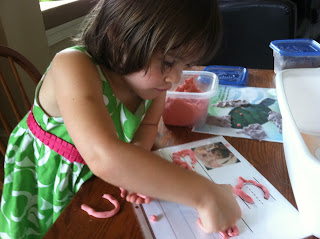Little House in the Big Woods Lap-book
I am using these two lap booking sites (
Lap book from Homeschool Share and
Lap book from lapbooklessons.com) and as a jumping point, but I am going to add to it as we go.
Cover page
Instead of the traditional Lap-book, I am using a pocket folder with prongs. I wanted to have more flexibility to add more information and less worrying about how to make it fit into a lap book.
Page One: Where is Wisconsin?
- Find Wisconsin on a map of the United States (www.enchantedlearning) and label it and Maryland (our home state). I felt that this was a necessary addition to the lap book.
Page 2: Wild Animals. This is taken from this
site and I added a pocket to keep them contained.


Page 3: The Smokehouse and Meat Preservation. Again the Smokehouse image is available from this
site and the Meat Preservation ia available from this
site. Instead of having Devon write out the steps of each, I made little bookmarks and we reviewed how each was preserved and completed a writing assignment with the bookmarks as our prewriting stage.


Page 4: In the Attic and the Butter Churn
In the Attic is an accordion style lap book piece that folds up to only show one item, but five items are folded behind it. Again this may be found on this
site. I used this activity to "reread" the selection and reinforce what was in the attic with the girls.
Just under the "In the Attic" I used the
Butter Churn fold out to document our butter making experiment. We used a glass jar, whipping cream, and two glass marbles. It took us 22 minutes to shake the heavy cream and to get it to break into buttermilk and butter. We then salted it and because my kids LOVE honey butter we added honey too. We shook our butter while completing the "How to make Butter" steps on the next page.


Again, I choose to make a pocket and give Devon Step One-Ten and then the 10 steps of butter making on another sheet and she had to match and glue them together. We did this while shaking our butter in turns. After we competed this pocket, we moved onto the chores mini-book. Both mini-book templates are available
here. These pages lead to a great conversation about the fact that Ma made butter only on Thursdays and it had to be enough to last the week. Every other day of the week had its own chore. We talked about how much time it would talk to churn enough butter for the week, when it took us 20 minutes for us to make our little bit of butter.




















































